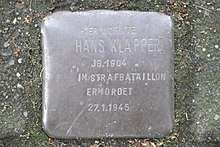999th Light Afrika Division (Wehrmacht)
| 999th Afrika Division | |
|---|---|
| Afrika-Division 999 | |
| Active | 6 October 1942 |
| Disbanded | 15 May 1943 |
| Country |
|
| Allegiance |
|
| Branch | Wehrmacht (Army) |
| Type | Infantry |
| Role | Penal military unit |
| Garrison/HQ | Heuberg |
The 999th Afrika Brigade was a German Army unit created in October 1942 as a penal military unit. It was later expanded into the 999th Light Afrika Division and began deploying to Tunisia in early 1943. However, this was interrupted by the surrender of Axis forces in that theater. Those elements that made it to Africa before the collapse fought as independent units rather than as a division, and were lost in the general collapse. The remainder were sent to Greece for garrison and anti-partisan duty,[1] where a number of those forced into service because of their anti-Nazi activities continued them, such as Falk Harnack, who deserted and formed the Anti-Fascist Committee for a Free Germany[2] with other soldiers. During the only fight many of the political prisoners in the division went over to the US troops or retreated, the US Army taking their positions without any heavy fighting.
Commanders
Commanders were:[3]
- Oberst Heinz Karl von Rinkleff – October 1942 to 2 February 1943 (transferred to Russian front after the surrender at Stalingrad)
- Generalleutnant Kurt Thomas (general) – 2 February 1943 to 1 April 1943) (KIA 1 April 1943 when his plane was shot down en route to Tunis.)
- Generalmajor Ernst-Günther Baade – 2 April 1943 to 13 May 1943)
Organization
Order of battle of Afrika-Brigade 999[3]
- Afrika-Schützen-Regiment (Infantry) 961
- Afrika-Schützen-Regiment 962
- Nachrichten-Kompanie (Communications) 999
Order of battle of 999 Afrika Division[3]
- Stab
- Divisions-Kartenstelle (Maps) 999
- Afrika-Schützen-Regiment 961
- Afrika-Schützen-Regiment 962
- Afrika-Schützen-Regiment 963
- Panzerjäger-Abteilung 999
- Artillerie-Regiment (Artillery) 999
- Pionier-Bataillon (Engineers) 999
- Aufklärungs-Abteilung (Reconnaissance) 999
- Astronomischer Messtrupp (Navigation) 999
- Werkstatt-Kompanie (Laboratory) 999
- Werkstatt-Kompanie 999
- Entgiftungs-Batterie (Detoxification) 999
- Nachschub-Bataillon (Supply) 999
- Schlächterei-Kompanie (Butchers) 999
- Bäckerei-Kompanie (Bakers) 999
- Divisions-Verpflegungsamt (Rations) 999
- Sanitäts-Kompanie (Medical) 999
- Krankenkraftwagen-Zug (Ambulance) 999
- Veterinär-Kompanie (Veterinary) 999
- Feldgendarmerie-Trupp (Military police) 999
- Feldpostamt (Postal) 999
See also

References
- ↑ Mark Mazower (1993). Inside Hitler's Greece: The Experience of Occupation, 1941-44. Yale University Press. p. 200. ISBN 978-0-300-06552-7.
- ↑ Gottfried Hamacher, Andre Lohmar, Herbert Mayer and Günter Wehner, Gegen Hitler: Deutsche in der Resistance, in den Streitkräften der Antihitlerkoalition und der Bewegung "Freies Deutschland" Dietz, Berlin (March 2005), p. 76. ISBN 3-320-02941-X (in German)
- 1 2 3 George F. Nafziger – The Afrika Korps: An organizational history 1941–1943
- Klausch, Hans-Peter (1986) "Die 999er: von der Brigade "Z" zur Afrika-Division 999 : die Bewährungsbataillone und ihr Anteil am antifaschistischen Widerstand". Retrieved December 2, 2015.
- Tessin, Georg (1976). Die Landstreitkräfte 801—13400 [Ground forces 801-13400]. Verbände und Truppen der deutschen Wehrmacht und Waffen-SS im Zweiten Weltkrieg 1939—1945. 13. Osnabrück: Biblio. p. 200. ISBN 978-3-7648-1029-0.
External links
- Wendel, Marcus (2004). "999. Afrika-Brigade". Retrieved April 4, 2005.
- "Afrika-Brigade 999". German language article at www.lexikon-der-wehrmacht.de. Retrieved April 4, 2005.
- militaryhistorynow.com Strafbataillon
- Condemned Men – Meet Hitler’s Penal Battalions, 29 July, 2013
- Strafbataillon 999, by Heinz G. Konsalik, first published January 1, 1962
- axishistory.com Penal units of the Heer, 07 April 2012